Components for Implantables
January 1, 2001
Originally Published January/February 2001
SPOTLIGHT
Components for Implantables
Custom microconductor coils and helices
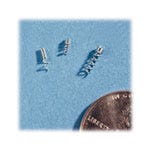 Microconductor coils and helices are produced as components for implantable pacing, defibrillation, and stimulation leads in cardiac, brain, and spinal cord therapeutic applications. Windable coil forms include unifilar to 12 filars—tapered, multiple pitch, stripped and dropped, and dogleg, with as small as 0.002-in. inner diam and tolerances to 0.0002 in. Medical-grade wire types that can be coiled include clad wire, DFT, braided, standard, and coated. Coils and helices can be coated with a variety of polymers and metal plating. Jerneen Micro Medical Technology, 475 Apollo Dr., Lino Lakes, MN 55014.
Microconductor coils and helices are produced as components for implantable pacing, defibrillation, and stimulation leads in cardiac, brain, and spinal cord therapeutic applications. Windable coil forms include unifilar to 12 filars—tapered, multiple pitch, stripped and dropped, and dogleg, with as small as 0.002-in. inner diam and tolerances to 0.0002 in. Medical-grade wire types that can be coiled include clad wire, DFT, braided, standard, and coated. Coils and helices can be coated with a variety of polymers and metal plating. Jerneen Micro Medical Technology, 475 Apollo Dr., Lino Lakes, MN 55014.
Stainless-steel electropolishing services
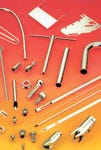 A provider of electropolishing services offers an alternative to buffing and machine tumbling, which can produce surface damage or distortion. Electropolishing passivates stainless-steel parts, removes burrs, and creates a bright, reflective surface finish that retards corrosion and resists the bacteria impregnation.It is a reverse plating process that selectively removes the high points on stainless steel with 0.0001-in. precision and deposits a clear, chemically bonded oxide. Electropolishing is a stress-free electrochemical process that involves immersing parts in an electrolytic bath and applying electrical current at a controlled rate. New England Electropolishing Company, Inc., 220 Shove St., Fall River, MA 02724.
A provider of electropolishing services offers an alternative to buffing and machine tumbling, which can produce surface damage or distortion. Electropolishing passivates stainless-steel parts, removes burrs, and creates a bright, reflective surface finish that retards corrosion and resists the bacteria impregnation.It is a reverse plating process that selectively removes the high points on stainless steel with 0.0001-in. precision and deposits a clear, chemically bonded oxide. Electropolishing is a stress-free electrochemical process that involves immersing parts in an electrolytic bath and applying electrical current at a controlled rate. New England Electropolishing Company, Inc., 220 Shove St., Fall River, MA 02724.
Miniature electronic modules
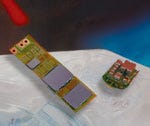 Specializing in miniature electronic modules for medical applications, a supplier has developed a component that provides greater functionality and reduced power consumption in a smaller package size than was previously available. The 3D-CSP module incorporates the company's flip-chip and flexible-circuit assembly technologies. The surface area of the two- or three-die component is approximately 1 mm more than a single traditional integrated circuit. The module, which was recently used in a hearing aid, is suited for any medical application where high density is desirable. Valtronic USA, 6168 Cochran Rd., Solon, OH 44139.
Specializing in miniature electronic modules for medical applications, a supplier has developed a component that provides greater functionality and reduced power consumption in a smaller package size than was previously available. The 3D-CSP module incorporates the company's flip-chip and flexible-circuit assembly technologies. The surface area of the two- or three-die component is approximately 1 mm more than a single traditional integrated circuit. The module, which was recently used in a hearing aid, is suited for any medical application where high density is desirable. Valtronic USA, 6168 Cochran Rd., Solon, OH 44139.
Custom-manufactured implantable components
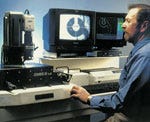 A company produces implantable components such as plates for reconstructive bone surgery, surgical tools, and catheter tipping molds, as well as hub molds for multilumen tubing. Prototyping and development, introductory quantities, and small-lot production quantities are provided. The company employs only craftsmen, toolmakers, die makers, mold makers, and precision machinists, and it is equipped with state-of-the-art CNC machine tools, including Wire and Sinker electric discharge machines. V & M Tool Co., Inc., 1303 North 5th St., Perkasie, PA 18944.
A company produces implantable components such as plates for reconstructive bone surgery, surgical tools, and catheter tipping molds, as well as hub molds for multilumen tubing. Prototyping and development, introductory quantities, and small-lot production quantities are provided. The company employs only craftsmen, toolmakers, die makers, mold makers, and precision machinists, and it is equipped with state-of-the-art CNC machine tools, including Wire and Sinker electric discharge machines. V & M Tool Co., Inc., 1303 North 5th St., Perkasie, PA 18944.
Tubular metal alloy drilling services
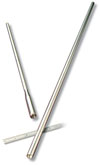 A drilling process can be applied to metal alloys in tubular form to produce close-tolerance, uniform-wall-thickness medical implants and devices. Materials such as nobium, molybdenum, and nickel and titanium alloys, and other hard-to-machine materials can be processed. Wall variations of 0.25 to 0.38 mm TIR can be maintained throughout a length of 400 to 500 mm. The devices produced feature a finished OD size—no finish turning is necessary to correct concentricity. Dearborn Precision Tubular Products Inc., 80 Portland St., Fryeburg, ME 04037.
A drilling process can be applied to metal alloys in tubular form to produce close-tolerance, uniform-wall-thickness medical implants and devices. Materials such as nobium, molybdenum, and nickel and titanium alloys, and other hard-to-machine materials can be processed. Wall variations of 0.25 to 0.38 mm TIR can be maintained throughout a length of 400 to 500 mm. The devices produced feature a finished OD size—no finish turning is necessary to correct concentricity. Dearborn Precision Tubular Products Inc., 80 Portland St., Fryeburg, ME 04037.
Shape-memory alloy components
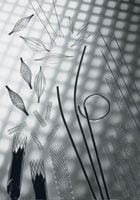 Stents, filters, baskets, couplers, and related parts are manufactured from shape-memory alloys by a company with extensive experience processing nickel titanium. Manufacturing processes that were developed in-house ensure that the material's functional properties are fully exploited in devices as small as 0.4 mm diam. Complex shapes and patterns are routinely manufactured from tubing and sheet with typical slot widths of 0.02 mm and strut widths of 0.1 mm. The company's capabilities include laser cutting and welding, thermal expansion treatment, design and material optimization, electropolishing, and radiopacity. Stainless steel, titanium, and tantalum are also processed. EUROflex Schüssler GmbH, Kaiser-Friedrich-Str. 7, Pforzheim D-75172, Germany.
Stents, filters, baskets, couplers, and related parts are manufactured from shape-memory alloys by a company with extensive experience processing nickel titanium. Manufacturing processes that were developed in-house ensure that the material's functional properties are fully exploited in devices as small as 0.4 mm diam. Complex shapes and patterns are routinely manufactured from tubing and sheet with typical slot widths of 0.02 mm and strut widths of 0.1 mm. The company's capabilities include laser cutting and welding, thermal expansion treatment, design and material optimization, electropolishing, and radiopacity. Stainless steel, titanium, and tantalum are also processed. EUROflex Schüssler GmbH, Kaiser-Friedrich-Str. 7, Pforzheim D-75172, Germany.
Polytetrafluoroethylene components
Expanded polytetrafluoroethylene (PTFE) is a soft, flexible, hydrophobic material with a porous microstructure that is air permeable yet tight under low pressures. Properties of PTFE include chemical resistance, high-temperature stability, and good dielectric and nonstick properties. PTFE components can be custom made to meet diameter, porosity, and wall thickness requirements. Impra Inc., P.O. Box 1740, Tempe, AZ 85280.
Antiadhesion biomaterial
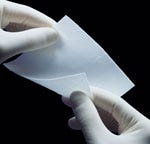 A new biomaterial is a combination of hyaluronic acid and carboxymethylcellulose deposited on a polypropylene mesh. The Sepramesh biosurgical composite separates tissue surfaces, while an adhesion-resistant cell layer develops over the surface of the mesh. Without the antiadhesion cell layer, adhesions typically form within seven days following surgery. Also available are synthetic absorbable polymer sutures. Genzyme Surgical Products, One Kendall Sq., Cambridge, MA 02139.
A new biomaterial is a combination of hyaluronic acid and carboxymethylcellulose deposited on a polypropylene mesh. The Sepramesh biosurgical composite separates tissue surfaces, while an adhesion-resistant cell layer develops over the surface of the mesh. Without the antiadhesion cell layer, adhesions typically form within seven days following surgery. Also available are synthetic absorbable polymer sutures. Genzyme Surgical Products, One Kendall Sq., Cambridge, MA 02139.
Injection-molded ceramic components
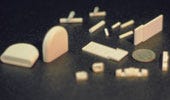 A ceramic component provider offers tubes of various lengths with up to 0.125-in. outer diam and as small as 0.01-in. walls. Highly shaped 2 x 1-in. lids with 0.01-in. walls can be used for hybrid electronic circuits. Ceramic components can be used as end effectors in laparoscopic, endoscopic, and other surgical procedures. The company also supplies zirconia cochlea implant cases. Quest Technology LP, 6750 Nancy Ridge Dr., San Diego, CA 92121.
A ceramic component provider offers tubes of various lengths with up to 0.125-in. outer diam and as small as 0.01-in. walls. Highly shaped 2 x 1-in. lids with 0.01-in. walls can be used for hybrid electronic circuits. Ceramic components can be used as end effectors in laparoscopic, endoscopic, and other surgical procedures. The company also supplies zirconia cochlea implant cases. Quest Technology LP, 6750 Nancy Ridge Dr., San Diego, CA 92121.
Radiopaque coatings and surface-texturing services
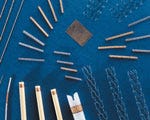 A company offers radiopaque coating deposition and ion beam surface-texturing services. Radiopaque materials stop x-rays, making a treated device visible on an x-ray or fluoroscopic image. Various radiopaque materials can be deposited as dense, well-adhered thin-film coatings in a variety of patterns such as marker bands and stripes. Both radiopaque coating application and ion beam surface texturing can be applied to metals and polymers. Ion beam texturing produces specific morphologies on metal and polymer surfaces, and a variety of uniformly or randomly spaced structure types can be produced. Ion beam–textured surfaces are durable and cannot delaminate because they are an intrinsic part of the underlying surface. Implant Sciences Corp., 107 Audubon Rd., #5, Wakefield, MA 01880.
A company offers radiopaque coating deposition and ion beam surface-texturing services. Radiopaque materials stop x-rays, making a treated device visible on an x-ray or fluoroscopic image. Various radiopaque materials can be deposited as dense, well-adhered thin-film coatings in a variety of patterns such as marker bands and stripes. Both radiopaque coating application and ion beam surface texturing can be applied to metals and polymers. Ion beam texturing produces specific morphologies on metal and polymer surfaces, and a variety of uniformly or randomly spaced structure types can be produced. Ion beam–textured surfaces are durable and cannot delaminate because they are an intrinsic part of the underlying surface. Implant Sciences Corp., 107 Audubon Rd., #5, Wakefield, MA 01880.
Back to the MPMN January/February 2001 table of contents | Back to the MPMN home page
Copyright ©2001 Medical Product Manufacturing News
You May Also Like


.png?width=300&auto=webp&quality=80&disable=upscale)